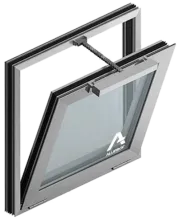Fire-resistant vents achieve their protective properties through different materials and technologies. Many include an inner honeycomb matrix coated with intumescent material. When exposed to high heat, the material expands, sealing the vent openings to block flames and embers. Other fire resistant vents designs use fine ember-resistant mesh, which allows for airflow while keeping fire out. Some fire resistant vents also use temperature-sensitive components that trigger automatic closures when high temperatures are detected. These systems are highly effective in cutting off fire pathways in ducts and ventilation systems, where the risk of fire spreading is particularly high.
There are different types of fire resistant vents which are all best suited to various parts of a building. Soffit and undereave fire resistant vents, installed beneath the eaves, provide attic ventilation while preventing ember intrusion. Gable fire vents, located on exterior walls near the roof peak, facilitate cross-ventilation and can be designed with ember-blocking features. Foundation vents, which allow air circulation in crawl spaces, are also available in fire resistant versions to protect these areas from fire threats.
In the UK, fire resistant vents must comply with relevant regulations such as the Building Regulations 2010, which outline fire safety requirements for structures. Approved Document B (Fire Safety) provides guidance on the use of materials and systems, including fire resistant vents, to limit the spread of fire and smoke in buildings. Testing practices in the UK, such as BS EN 1366-2, evaluate the fire resistance of ventilation ducts and their ability to prevent fire and smoke transfer. These standards ensure that fire-resistant vents meet rigorous safety benchmarks.
Proper installation is crucial to the effectiveness of fire resistant vents. Installers must ensure compliance with UK fire safety standards and guidelines, particularly in high-risk areas such as multi-storey residential buildings or commercial premises. Professional installation is recommended to avoid errors that could compromise safety. Additionally, regular inspections and maintenance are necessary to ensure vents remain debris-free and functional over time.
Installing fire-resistant vents offers numerous benefits. They enhance safety by significantly reducing the risk of ember and flame intrusion, which lowers the likelihood of internal fires during wildfires. They also maintain proper ventilation, preventing moisture buildup and ensuring good indoor air quality. Additionally, homes equipped with fire-resistant features, such as these vents, often have higher property values and appeal to buyers who prioritize safety.
At Fireresist.co, we are committed to delivering fire-resistant vents that meet the industry standards and exceed customer expectations. All our products are tested to comply with UK regulations, including the Building Regulations 2010 and standards such as BS EN 1366-2. Using high quality materials such as intumescent-coated honeycomb matrices and ember-resistant meshes, we ensure our vents provide reliable protection without compromising ventilation. Our designs are engineered for durability, efficiency, and ease of installation, making them a cornerstone of passive fire protection systems. By choosing Fireresist.co, you’re investing in proven solutions that prioritize safety, quality, and compliance.

